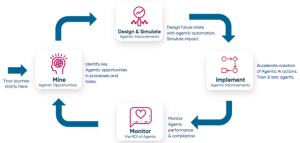

Artificial Intelligence (AI) is not just reshaping technology — it’s revolutionizing how businesses operate. In the field of business process management (BPM) and business transformation software, Generative AI (GenAI) emerges as a strong catalyst for growth, influencing everything from process discovery through to enterprise architecture and process automation. For software businesses and their investors, understanding the trajectory of this transformation is crucial in order to capitalize on emerging opportunities.
Agentic Automation represents a paradigm shift within the domain of process automation. Unlike traditional robotic process automation (RPA) bots, which follow deterministic rules, AI agents operate with non-deterministic control flows within preset boundaries, making autonomous decisions and adapting to new data inputs, as they work alongside users in achieving certain business goals. As Craig Le Clair (2024), Principal Analyst at Forrester puts it:
“The goal of agentic process automation is to be the orchestration element, linking deterministic automation assets and transitioning them into autonomous, non-deterministic patterns.”
AI agents are capable of tasks that were once the domain of human decision-makers. In KYC processes, for example, Airwallex reported that the introduction of an AI Agent reduced false positives by 50% while boosting the number of customers that pass through the onboarding process without human intervention by 20% (Airwallex, 2023).
Process Mining: The gateway to effective Agentic Automation
Process mining and agentic automation share a symbiotic relationship: process mining uncovers where within a business process automation will be most impactful, while agentic automation delivers solutions that can be refined through continuous process insights. This interplay creates a feedback loop — insights drive action, and automation outcomes inform ongoing improvement. In this context, process mining serves as both the starting point and the guiding compass for effective GenAI adoption, monitoring and improvement (Dumas, 2025). To make this more concrete, let us consider the following synergies.
Apromore’s Copilot uses GenAI to enhance user experience in process discovery and simulation.
These developments position process mining not only as a diagnostic tool but also as a strategic enabler for Agentic AI adoption, giving a significant boost to the total addressable market that these tools tap into. By highlighting which processes and tasks are most ripe for automation, and providing insights into the underlying reasons behind inefficiencies, process mining software lays the groundwork for seamless integration of AI agents into business operations.
Celonis and Apromore: two process mining leaders
Celonis and Apromore are two leading vendors at the forefront of process mining innovation, significantly advancing the integration of process mining with agentic automation and both exemplifying how the synergies as discussed above unlock the value of GenAI for the enterprise. Celonis, headquartered in Munich and New York, provides its renowned Process Intelligence Platform – recognized in Gartner’s Magic Quadrant – which leverages the Process Intelligence Graph and object-centric process mining and augments it with business context to deliver a dynamic digital twin of business operations. Celonis’ extensive global presence includes circa half of the top 200 companies of the Forbes Global 2000, more than 30% of the Fortune Global 500, and more than 25% of the Fortune 500, reflecting a value realization through its Process Intelligence Platform exceeding $6.7 billion. The company’s approach emphasizes identifying high-impact AI use cases, developing intelligent agents and copilots (with AgentC integrations and APIs), orchestrating automation across end-to-end processes (also using pre-built apps from partners), and continuously monitoring business improvements delivered by AI and automation deployments. Additionally, Celonis extends these capabilities beyond individual enterprises through Celonis Networks, enhancing process transparency and optimization across complex, multi-enterprise environments such as supply chains.
Celonis’ Process Intelligence Platform components
“In a world defined by change, innovation isn’t optional, it’s essential. Celonis is proud to be recognized among the most forward-thinking companies for our relentless pursuit of creating value for our customers,” said Alex Rinke, co-CEO and co-founder of Celonis in press release about the company being named to Fast Company’s Annual List of the World’s Most Innovative Companies of 2025. “This honor is a testament to the hard work of our Celonauts, our customers and partners, and the game-changing impact of Process Intelligence, which empowers businesses to eliminate inefficiencies, supercharge AI initiatives, and drive sustainable, long-term business impact.”
Similarly, Apromore – another leader in Gartner’s Magic Quadrant – headquartered in Melbourne and New York, has built its platform on over a decade of research and innovation at the University of Melbourne (Australia) and the University of Tartu (Estonia). Its no-code, AI-driven solution has helped organizations around the globe monitor and improve more than 2,500 processes, resulting in an average process efficiency increase of 51% and over 7,400 hours of work saved for its clients. Apromore’s distinctive “Roundtrip Process Mining” method systematically combines process mining and agentic automation, enabling clients to identify process inefficiencies, design and simulate future-state automation strategies, train AI agents with extracted topics via task mining, and deploy and continuously monitor agents for compliance and performance improvements.

Apromore’s Roundtrip Process Mining approach for enabling agentic automation
Marcello La Rosa, CEO of Apromore: “Process mining has emerged as a critical solution for businesses seeking to enhance operational efficiency, enable better customer experience, and accelerate digital transformation. We’re proud to see such strong interest in Apromore, which not only validates our vision and current trajectory but also fuels our ambition to define what’s possible in the field of operational intelligence. Especially in a world where AI agents can take over specific tasks, optimizing end-to-end processes in a systematic approach through our offering can really make a difference.”
Identifying what to automate and monitoring agents in siloed environments is only half the battle however – ensuring that these automated processes integrate seamlessly into the broader organizational landscape is the next critical step. This is where enterprise architecture tools come into play. By translating the insights gained from process mining into actionable architectural strategies, enterprise architecture platforms ensure that GenAI-driven automation initiatives are sustainable, scalable, and aligned with long-term business objectives.
How Enterprise Architecture tools facilitate GenAI integration
Enterprise Architecture Management Software (EAMS) plays a crucial role in managing complex IT landscapes, ensuring that technology investments align with business objectives. EAMS provides a holistic view of an organization’s architecture and IT landscape, encompassing business processes, applications, data, and technology, providing insights into the dependencies between them, duplication or misalignment of IT, and the impacts of planned changes. History shows that when disruptive technologies emerge – like the early days of e-commerce – organizations often isolate them in separate silos, leading to long-term inefficiencies. To avoid repeating this mistake with AI, enterprise architecture tools such as Bizzdesign play a pivotal role in facilitating the seamless integration of GenAI into existing organizational landscapes. These tools provide structured frameworks that help enterprises embed AI capabilities within established business functions rather than creating isolated experiments. By enabling clear visualization of how AI agents interact with processes, data flows, and technology layers, enterprise architecture platforms ensure that AI integration aligns with business objectives and avoids redundancy.
Enterprise architecture tools facilitate the successful integration of GenAI in the organization in multiple key ways:
These factors not only improve operational resilience but also unlock faster innovation cycles – a critical consideration for software executives and investors alike.
Bizzdesign: A Leader in EAMS
Bizzdesign is recognized as a leader in the EAMS space (see the Forrester Wave for Enterprise Architecture Management Suites). Bizzdesign is known for its robust solutions that help organizations navigate complex IT landscapes and their platform enables businesses to align their IT infrastructure with strategic goals, ensuring agility, efficiency, and compliance. By leveraging Bizzdesign’s EAMS, organizations can effectively manage the adoption and maintainability of Agentic AI, driving innovation and operational excellence.
Nick Reed, Chief Strategy Officer at Bizzdesign: “Successfully adopting generative AI is the number one priority for enterprises today. But it comes with huge risks – privacy, security, reputation – if not implemented in a coordinated, well-governed way. Business leaders need visibility of where the opportunities for business improvement are, transparency of what is deployed where, and the dependencies and impacts on processes, data, technology and compliance. EA platforms are crucial for bringing together this information in a single source of truth that provides these insights to all stakeholders, to accelerate value creation through faster execution of strategy, from idea to operation. Several Bizzdesign customers are already taking advantage of this to deliver game-changing results.”
Massimo Capoccia, former VP of Product Strategy at ERP vendor and current supervisory board member of Bizzdesign: “Enterprise Architecture as an organizational capability is essential for multinationals and larger corporations in transition – for managing their complex IT landscapes and business processes (redesign). Enterprise Architecture as a profession, framework and methodology is rather mature and based on internally accepted standards. With the rapid adoption of AI within larger organizations, not just generative AI for relatively stand-alone use cases (e.g. writing content for marketing material) but especially with agentic AI integrating deeply in the data, infrastructure and system layer of organizations – the correct use of enterprise architecture management software becomes undisputably relevant to keep control over IT and business operations.”
Conclusion
GenAI and agentic automation are more than technological trends – they are catalysts for fundamental business change. By leveraging process mining tools to identify what to automate and enterprise architecture platforms to integrate these innovations into the broader IT landscape, companies can avoid the pitfalls of siloed initiatives and build scalable, resilient AI strategies. Innovative vendors like Apromore and Bizzdesign exemplify the potential of AI in these fields, setting a benchmark for others to follow. For software executives and investors, now is the time to engage, invest, and lead in this evolving landscape.
Sven van Berge Henegouwen, Managing Partner at Main Capital and lead investor in Main’s Business Transformation Software portfolio, concludes: “AI-driven process mining and enterprise architecture management are revolutionizing the way businesses operate. By integrating these advanced technologies, companies can achieve unmatched efficiency, precision, and strategic insights, catalyzing transformative change across industries. As a pure software investor, with more than 20 years’ experience in the industry, we constantly analyze trends and developments in the market and find the right investment areas for our company, portfolio and LPs. With our dedicated Product, Tech & AI capability within our Performance Excellence practice, we push innovation and make impact together with portfolio companies every day.”
References
Le Clair, C. (2024, December 12). The Rise of Agentic Process Automation [Video]. YouTube. https://www.youtube.com/watch?v=CldVWpye4Wk
Airwallex (2023, December 6). Airwallex improves customer onboarding with generative AI. https://www.airwallex.com/newsroom/airwallex-improves-customer-onboarding-with-generative-ai
van der Aalst, W. (2023, December 7). Process Management after ChatGPT: How Generative and Predictive AI Relate to Process Mining. LinkedIn. https://www.linkedin.com/pulse/process-management-after-chatgpt-how-generative-ai-wil-van-der-aalst-lyyzc/
Dumas, M. (2025, April 2). Process intelligence: The foundation of agentic AI success. PEX Network. https://www.processexcellencenetwork.com/ai/articles/process-intelligence-agentic-ai
